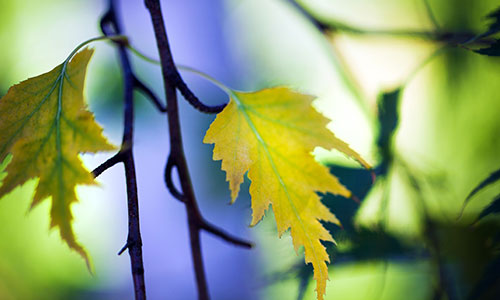Ideas for adding variety to late-season Alberta landscapes
Think of fall in Eastern Canada and a landscape of red and orange comes to mind. Consider the same in the west and the scenery may seem less dramatic. “On the Prairies we have notoriously short falls,” says Dan Tavenier, NAIT landscape gardener. As a result, plants known for fall colour aren’t often part of the gardener’s pallet.
But could that be changing? Recent autumns in Edmonton have been warm and lengthy, coaxing out the showier pigments masked by the green of spring and summer. What’s more, data shows that the season is warming, postponing frosts that strip plants bare.
It may not happen every year, says Tavenier, but if enough rainfall precedes the season, chances of a burst of colour before winter are good. For gardeners, that may be something to plan for once summer flowers have faded away.
“Every fall I keep my eyes open,” says Tavenier. “I’m often surprised by what shows up.”
Here’s a look at 10 trees, shrubs and perennials at NAIT Main Campus that may open eyes to the growing potential of fall in Alberta.

 |
1. Cutleaf weeping birch (Betula pendula)
12 metres (40 feet) tall, 6m (20 feet) wide
Already a standout for its graceful hanging branches and delicately serrated leaves, this tree is also unique for how consistently it colours come fall, says Tavenier. Expect a transition to a solid mass of brilliant yellow, feathery foliage.
|
 |
2. Burning bush (Euonymus alatus)
1.8m (6 feet) tall, 2.4m (8 feet) wide
If reasonably sheltered from the elements and planted in soil with even moisture, the burning bush can go fiery red in the fall. Tavenier likes it for its summer features, too. “I find the layering of the foliage has a tropical look to it.” The fruit is also unusual, with a look “almost like a paper capsule.”
|
 |
3. Turkestan burning bush (Euonymus nanus)
60 centimetres (24 inches) tall, 75cm (30 inches) wide
Tougher than the burning bush, the Turkestan variety “has a unique grassy look to it. And again the fruit is very interesting,” says Tavenier. Use it for a late-season pop of red-purple in a small space.
|
 |
4. American highbush cranberry (Viburnum trilobum)
3m (10 feet) tall, 2.7m (9 feet) wide
Edmonton river valley walkers will have noticed the native variety with its dense, red, maple-shaped leaves and clusters of crimson berries. “The eye-catching scarlet fruit only adds to the display,” says Tavenier. Small varieties are available and will deliver the same autumn results.
|
 |
5. Alpine currant (Ribes alpinum)
1.8m (6 feet) tall, 1.5m (5 feet) wide
Watch for a late-season mix of green, red and bronze from this compact shrub. Though not native to North America, the alpine currant is adaptable to a variety of soil types and is drought tolerant.
|
 |
6. Red osier dogwood (Cornus sericea)
2.4m (8 feet) tall, 1.8m (6 feet) wide
A reliable native plant, the red osier or red-twigged dogwood does double duty when it comes to post-summer colour. While the leaves go purple-red, the real show is in winter. Fallen snow makes the perfect contrast for the scarlet bark.
|
 |
7. American elm (Ulmus americana)
24m (80 feet) tall, 15m (50 feet) wide
Not for the small of yard, this massive shade tree trades green for bright yellow, lighting up like a torch as the summer days shorten. If you’ve got room, “it can be a spectacular tree,” says Tavenier.
|
 |
8. Hosta (Fortunei aureomarginata)
50cm (20 inches) tall, 90-120cm (35-47 inches) wide
A popular perennial, hostas can enhance the fall landscape if grown in a moist location. This older variety adds yellow to leaves with thick white margins.
|
 |
9. Amur maple (Acer ginnala)
5m (15 feet) tall, 3m (10 feet) wide
Space needn’t always be sacrificed for a tree with great fall colour. Many varieties of amur maple stay relatively small while delivering a spectacular show of yellow-red leaves. “They’re pretty hard to beat,” says Tavenier.
|
 |
10. Korean maple (Acer pseudosieboldianum)
5m (15 feet) tall, 3m (10 feet) wide
Even when green the Korean maple looks exotic, featuring ornate foliage and a cascading branch structure. In the right fall conditions, it’s a beacon of bright orange. Said to be borderline hardy, a lone specimen survives at NAIT despite a lack of protection, colouring up every year. “That’s part of the mystery that we deal with in this business,” says Tavenier. “Sometimes it defies all logic.”
|
